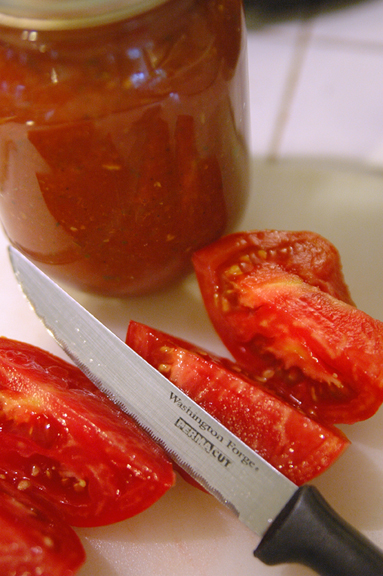Finally in the zone, the canning comfort zone. Really, for most people isn’t this why they got into canning in the first place? Solanum lycopersicum, the garden tomato. When reading through plant catalogs it is the siren of summer, with her beguiling aliases: Mortgage Lifter, Brandywine, Cherokee Purple, Cuore Di Bue, Green Zebra … She seduces you into ordering dozens of plants with the anticipation of this very moment, the canning of the tomato.
Was there ever any doubt what this month’s can jam theme would be? It had to be her. And as comforting as this ingredient is to me, it was still hard. Hard to do something other than make sauce. Because I horde sauce. I dream of sauce. I have nightmares about running out of sauce. There can never be enough sauce in my larder to make me think that I have enough.
But sauce is pretty boring, and I wanted to do something a little interesting. Not all like crazy weird I’ll never use the product, but something a little more complex. So I allotted some of my precious tomatoes to this task – and if tasting is any indication it was an acceptable gamble.
Canned Pizza Sauce
The Hardware: see The Canning Thing, 3 – 4 pint jars (or any combination of half pints and pints to hold between 3 & 4 pints), food mill, potato masher and a cheap a$$ serrated knife. Now, I don’t usually spend a great deal of time on hardware, I just assume if you are cooking you know what you like to cook with. But I want to take a moment to talk about cutting tomatoes.
I am a knife snob. Sharp and strong is the way I like them, I don’t have many but the ones I have are choice. All last year during tomato canning I worked with a combination of my Henkel paring and bread knives, using the paring to cut out cores and such then the bread knife for cutting the bad boys into pieces. This year I had a rude awakening. I realized that the cheap block-o-knives steak knives that my hubby brought into our relationship, the ones that were relegated to the gulag of the junk drawer, were the best knives to use for processing my tomatoes. The pointy tip will cut out bad spots and the serrated “never sharpen” edges saw through tomatoes like buttah. I am chagrined.
The Software:
10 lbs Tomatos
4 Cloves Garlic, mashed
2 t Oregano, dried
3/4 t Black Pepper
2 t Italian Seasoning herb mix
3 C Chopped Onions
2 1/2 t Salt
3 T Brown Sugar
1/2 t Garlic/Chili paste
1 T Lemon Juice per pint
Remove cores and bad spots from tomatoes, slice in half or more depending on size, chuck into goodly sized non-reactive pot. Sprinkle with a bit of salt and squoosh with a potato masher. Bring to a simmer and cook until you can mash the biggest piece on the side of the pot with a spoon. Run through food mill and return to pot. Feed all scraps to chickens.
Add everything else except the lemon juice to the pot and simmer until the onions are soft – run through food mill a second time. (You might want to hold off on the chili paste and add that to taste depending on how spicy you like things.) Return everything to the pot (including the stuff that wouldn’t go through the mill – I like chunkies) and simmer until reduced to desired thickness. You know, pizza sauce thickness ie: thicker than a standard sauce but not paste consistency.
Add 1 T of lemon juice per pint and 1 1/2 t for a half pint – fill using your fancy canning gear and stir up a little to mix the lemon in before you lid up. 1/4 inch head-space, Boiling Water Bath for 35 minutes (sea level) adjust for your altitude.
Am I happy?
Yeah, I am happy I made this. Now I can have instant pizza sauce whenever I desire. It was hard, because for that 10 lbs of tomatoes I could have had 4 – 5 pints of sauce. The reducing kills me, I feel like I am simmering away precious tomato goodness. But I know that is silly.
Unfortunately my tomato plants are not producing as I would like this year. I managed to pull this off with home-grown, but if I am to have a larder that will allow me to sleep at night I might have to resort to the farmer’s markets. Tell me truthfully, for you, how much is enough? Do I have a problem?
ps: If I had known then what I know now, I might have held off on my Salsa Verde post and put it here instead. I am afraid that the tomatillo isn’t going to get the face time it should in this months round-up. The green stuff vs the red stuff is a Sophie’s Choice kind of conundrum for me. So take a moment and give some love to the little green guy.







